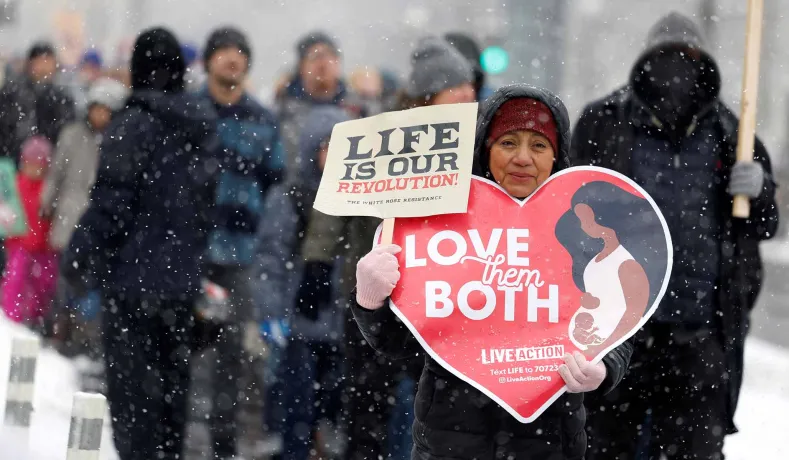
Published January 25, 2024
Who is most at fault when a woman obtains an abortion? What does it say about a society if its women seek abortions because they feel they have no other choice? In the 19th and early 20th centuries, these questions lay at the heart of the cultural conversation over abortion, as activists and reformers grappled with how best to create social conditions that would support women and protect unborn children.
More than a century later, such a conversation is nearly impossible, not least because many Americans are convinced that there is nothing wrong with abortion at all. No one is to blame when women seek abortion, and nothing needs to be done to prevent it, the thinking goes, because abortion is neither undesirable nor even especially concerning. Instead, many now see it as the obvious solution — indeed, the laudable choice — when women find themselves pregnant and wish not to be.
In their new book, Pity for Evil: Suffrage, Abortion, and Women’s Empowerment in Reconstruction America, scholars Monica Klem and Madeleine McDowell present a richly documented demonstration that this wasn’t always the case, and that our country was better for it. A century ago, nearly everyone did consider abortion a problem, no matter who they believed bore the lion’s share of responsibility.
Pity for Evil introduces readers to key figures in the post–Civil War and pre–19th Amendment women’s-rights movement who focused their advocacy on the interrelated topics of marriage, sex, reproduction, and abortion. The authors don’t offer much guidance as to how their book might assist us as we confront these same topics in a country utterly transformed by technological changes and shifts in mores. Nevertheless, much of the history they present will help informed readers think more deeply about today’s conversations surrounding feminism and abortion.
Judged purely by its contributions to the historical record, Pity for Evil has much to offer. The book examines major events and institutions of the early women’s-rights movement, giving readers a deeper understanding of how leaders at the time conceptualized male–female relationships and encouraged social change for the sake of equality and justice. The authors marshal substantial evidence that many of the period’s most prominent women’s-rights advocates believed that abortion was immoral not only because it killed unborn children but because it harmed women and perpetuated unjust social dynamics.
Klem and McDowell survey, for example, notable cases in which pregnant mothers died as a result of botched abortions, some of which were performed against their will. In other cases, they consider stories of women who were punished for engaging in prostitution or seeking abortions, while the men involved — including abortionists — evaded censure. In this regard, Pity for Evil might be compared to another recent book, The Story of Abortion in America: A Street-Level History, 1652–2022, by Marvin Olasky and Leah Savas, which likewise established a historical record of abortion’s grave risks to women and the unequal societal standards to which women were held.
The suffragists and other early anti-abortion advocates whose speeches and writings fill Pity for Evil didn’t confine their criticisms of abortion to its destruction of unborn life or to the way in which it harmed maternal health. They also lamented that abortion functioned as an escape hatch for irresponsible fathers and furthered what Klem and McDowell call the “sexual double standard,” by which society demanded virtuous behavior and chastity of women while largely ignoring the equal responsibility of men to act virtuously. Women were expected to be sexual gatekeepers, resisting male advances outside of marriage and taking the full share of blame when the customs of the time were violated. This fostered a climate in which only women were stigmatized for participating in various forms of sexual dissolution, while men generally could evade consequences, including and especially in the event of pregnancy outside of marriage.
In such a landscape, pro-woman activists understood that, in addition to being immoral, abortion failed to alleviate the unequal burdens society placed on women. In contrast with modern feminists, they regarded abortion as a failure of society to address the real, often understandable reasons that women sought abortion in the first place. They advocated the adoption of new societal standards that would require the same level of virtue and chastity from men and women and offer women opportunities to restore their standing after violating sexual norms.
The authors quote spiritualist and women’s-rights advocate Mary Fenn Davis on this point: “Davis . . . put forward resolutions on ‘the homeless and unprotected condition of those upon whom, by misfortune or crime, is laid the burden of unlegalized maternity.’ Davis’s resolutions decried the sexual double standard that left such women ‘bereft of social position and debarred from all opportunity to retrieve their error and to rise to honor and preferment in respectable communities.’”
Far from being a step in the direction of greater equality and justice for women, abortion placed yet another unequal burden on their shoulders, offering pregnant women in less than ideal circumstances a tempting yet immoral and physically dangerous method of escaping social shame and the responsibility of child-rearing.
This thorough exploration of the sexual double standard is perhaps Pity for Evil’s most helpful contribution to our present debates over sex, female equality, and abortion. The women’s-rights advocates they survey sought to promote equality and dignity for women within the context of the biological realities of sex and pregnancy, a striking contrast with those who bill themselves as defenders of women’s rights today.
Aided by the advent of fairly effective oral contraception, second- and third-wave feminists have argued that there is no longer any inherent connection between sex and pregnancy — indeed, that it would be unfair to regard conception as a natural outcome of sex and to require women to continue gestating an already conceived child. This has resulted in a model of female emancipation that considers consequence-free sex a basic element of human flourishing and demands legal abortion as a backstop when pregnancy occurs.
This intellectual shift has produced a pro-abortion movement inclined to argue that pro-lifers want to force motherhood upon unwilling women. “Banning abortion is forcing pregnancy” is how the American Civil Liberties Union put it when Roe v. Wade was on the chopping block. During the Supreme Court oral arguments in Dobbs v. Jackson Women’s Health Organization, the legal team opposing Mississippi’s pro-life law made a similar claim: “For a state to take control of a woman’s body and demand that she go through pregnancy and childbirth, with all the physical risks and life-altering consequences that brings, is a fundamental deprivation of her liberty.”
But laws against abortion don’t force women to become mothers against their will; they prohibit women who are already mothers from exercising lethal violence against their children in the womb. This essential distinction is lost on those who believe that pregnancy has no natural connection to sex because, thanks to widespread acceptance of contraception, the conception of an unwanted child is something like a violation of the terms of service. Consent to sex, in other words, is no longer viewed as consent to the possibility of pregnancy and parenthood. From this mind-set follows the belief that taking abortion off the table renders women unequal, unable to participate in sex with the same irresponsibility that men can exercise owing to the nature of their role in reproduction.
The activists whom Klem and McDowell study surely would have been appalled by so vicious and shallow a vision of female equality. Indeed, Pity for Evil explores a wholly different use of the term “forced maternity,” which invoked a woman’s right to decline sex when pregnancy was undesired. “It was not surprising that women sought abortions when their husbands pursued contradictory ends — the at-will satisfaction of sexual desire and the curtailing of family size — with similar insistence, and without discussing ‘this subject of deepest and most vital interest’ with their wives,” the authors write, quoting activist Matilda Joslyn Gage. “Both women and children were the losers in this scenario: ‘Enforced motherhood is a crime against the body of the mother and the soul of the child.’”
The pro-woman leaders showcased in the book realized that the connection between sex and pregnancy required an effort to restructure society in support of women, who bear unique responsibility to the child in the womb as a result of their very biology. Far from rejecting marriage or demanding abortion, these thinkers believed that society should embrace a vision of marriage as a partnership between a man and a woman with equal dignity and equal rights, a context in which husband and wife could share in the responsibilities of child-rearing — and childbearing women could depend on the social protection of marriage to provide necessary male support.
As Americans in a post-Dobbs country continue to debate whether there is a place for abortion in our society, Pity for Evil reminds us that ending abortion will ultimately require establishing cultural conditions that make abortion unappealing to women, including a return to virtue and a renewal of marriage.
EPPC Fellow Alexandra DeSanctis writes on culture and family issues, with a particular focus on abortion policy and pro-life advocacy, as a member of the Life and Family Initiative.












